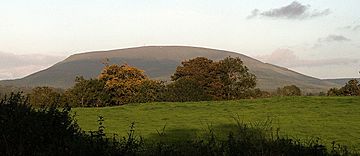Silvermine Mountains facts for kids
Quick facts for kids Silvermine Mountains |
|
|---|---|
| Sliabh an Airgid | |

Keeper Hill
|
|
| Highest point | |
| Peak | Keeper Hill |
| Elevation | 694 m (2,277 ft) |
| Geography | |
| Country | Republic of Ireland |
| Provinces of Ireland | Munster |
The Silvermine Mountains are a group of hills in County Tipperary, Ireland. They are also known as the Silvermines Mountains. In the Irish language, they are called Sliabh an Airgid.
The tallest point in this mountain range is Keeper Hill. It stands at 694 meters (about 2,277 feet) high. Long ago, people thought these mountains were part of the Slieve Felim Mountains.
The small village of Silvermines is located north of the mountains. This area has been important for mining since the 1300s.
Contents
Special Nature Areas
The Silvermine Mountains are home to three special places. These are called Special Areas of Conservation (SACs). They protect important plants and habitats.
Silvermine Mountains SAC
This area protects wet heaths. These are open lands with small shrubs like Erica tetralix (a type of heather). It also has grasslands rich in different plant species.
Silvermines Mountains West SAC
This SAC also has wet heaths with Erica tetralix. It protects dry heaths too. A special type of grassland here is called Calaminarian grassland. This soil has high levels of metals like lead. Many plants cannot grow here, but special ones can.
Keeper Hill SAC
This area is known for its wet heaths with Erica tetralix. It also has large areas of blanket bogs. These are wetlands where peat, a type of soil made from dead plants, builds up.
Mountain History
People have been mining in the Silvermine Mountains for a very long time. The first records of mining here are from 1289. Miners from Italy came to work in the mines.
They dug for silver, which was used to make coins. They also found lead, which was used for building materials. For example, lead was used for the roofs of new monasteries in the 1200s.
Mining continued on and off for over 600 years. By the mid-1800s, there were three engine houses. These houses had large machines called beam engines. They helped crush rocks, lift materials, and pump water out of the mines.
A new period of mining began in the 1960s. A large new deposit of valuable minerals was found. Miners worked both on the surface and underground. Mining stopped in 1984. It left behind piles of waste rock and ponds filled with mining leftovers.
Slieve Felim Walking Trail
The Slieve Felim Way is a long walking path. It is about 43 kilometers (27 miles) long. This trail goes through both the Silvermine Mountains and the Slieve Felim Mountains.
The trail starts in the village of Silvermines. It is known as a National Waymarked Trail. This means it is an official walking route in Ireland. The Irish Sports Council helps manage this trail.
See also
 In Spanish: Montañas Silvermines para niños
In Spanish: Montañas Silvermines para niños

